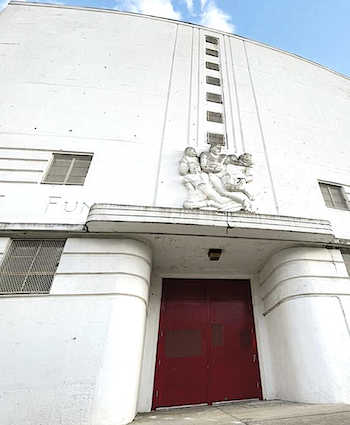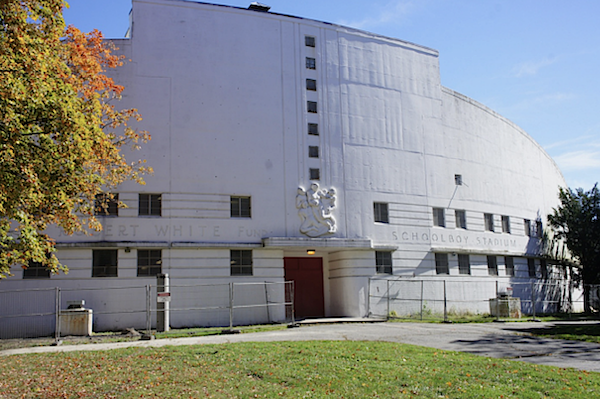Design Commentary: The Future of Boston’s White Stadium — A Public/Private Gordian Knot
By Mark Favermann
Many in the increasingly vocal community of stakeholders feel strongly that tradition, history, and student sports will be the victims of this apparent corporate/public conflict.

A close-up of the entry to Franklin Park’s George Robert White Stadium. Photo: City of Boston’s Planning and Development Agency
Boston’s venerable George Robert White Stadium has been neglected by generations of the city’s politicians and bureaucrats. The mistreatment is an ongoing public disgrace. Located in Franklin Park and created as a place for Boston Public School students to play sports, the building has long been in disrepair and has been only superficially maintained during most of its 75+ years of existence.
Designed by the architecture firm of Desmond and Lord, White Stadium is a rare example, in Boston, of Streamline Moderne, an Art Deco style that reflects a prewar Bauhaus influence. Another distinction: the designers made use of decorative horizontal lines referencing ship and train designs in motion. The structure’s shape underscores its athletic function: the West Stands bulge at the center, which provides a strong visual focal point while at the same time allowing for additional seating —10,000 in all.
Created as one of the anchors of the Emerald Necklace, Franklin Park was organized into four segments or areas: The Wilderness, The Meadows, The Greeting, and The Playstead.
Conforming to the 1890s vision of Franklin Park’s designer, Frederick Law Olmsted, White Stadium was architecturally designed to meet the goals of the Playstead Section. It was a venue for large public gatherings and active recreation. The key phrase is “large public gatherings.”
Keep that in mind, given current developments regarding the stadium. Last summer, with great fanfare, Boston announced that it was partnering with a for-profit organization, Boston Unity Soccer Partners, to restore, renovate, partially demolish, and eventually expand White Stadium. This effort was to encourage a Boston-based National Women’s Soccer League (NWSL) team to lease the stadium for all their home games and practices. The deal asked that the Boston Unity Soccer Partners pony up $50 million for renovations and repairs to be matched by $50 million from the City of Boston. Playing ball with the all-female investment group’s professional soccer organization, the Boston Planning and Development Agency (BPDA) bullet-trained the planning approval process for the project. The public’s access to the proceedings was prescribed, in some cases even shut down. Olmstead must be rolling over in his grave.
Boston Mayor Michelle Wu announced, “It is an extraordinary opportunity that we as a city have been awarded a professional soccer team,” But — and it is a “huge but” — all parties are not copacetic with the city’s plans. First and foremost, the Boston Public Schools will not be able to use the field from March through November. Forget football and track & field — no sports on the weekends. What about BPS student needs? Besides objections raised by residents and abutters, a growing number of neighborhood associations and advocacy groups are raising concerns about how the plans are going to affect the community’s quality of life. What about community events and activities, environmental impact? And then there is traffic and parking spaces for 11,000 visitors.

Franklin Park’s White Stadium today. Photo: City of Boston’s Planning and Development Agency
The Emerald Necklace Conservancy filed a lawsuit against the City of Boston to halt the plans for White Stadium, along with residents of Mattapan, Jamaica Plain, and Roxbury. The allegation is that the business arrangement would amount to privatization of the stadium as well as the three acres of public land surrounding it. This lawsuit aims to slow down the process while giving the public an opportunity to talk about how the business deal will impact the environment as well as the neighborhood. On March 24, 2024, a Massachusetts judge rejected a preliminary injunction to block the agreement with the Boston Unity Soccer Partners.
This is an example of privatization/public gridlock — maybe even a Gordian Knot that entwines equity/fairness issues on a number of different levels. Winners would seem to be the private investment group’s professional soccer team; the losers would appear to be Boston Public School student/athletes and local neighborhood residents. But maybe not.
Many in the increasingly vocal community of stakeholders feel strongly that tradition, history, and student sports will be victims of this apparent corporate/public conflict. But Boston Unity Soccer Partners begs to differ. It says that the long-term outcome will be a state-of-the-art sports facility, new offices for the Boston Public School Athletic Department, and planned community mitigation events and celebrations.
The promised benefits also will include a $500,000 annual community benefit fund, a professionally maintained stadium and playing surface, a neighborhood “fan zone,” whose tickets will be discounted, internship and mentorship opportunities for the community’s youth, and meaningful commitments to local, minority, women, and veteran-owned businesses. What’s more, the city and the Boston Unity Soccer Partnership pledge that they will partner closely to ensure smooth and efficient stadium operations.
Is this stadium refurbishment going to provide Boston Public School students a new and much needed sports venue? Or will it mainly become a venue for professional women’s soccer? Let’s face it, Boston loves its professional sports franchises, but not so much its student athletes. Politically, this is a peculiar showdown. A women-owned soccer team consortium versus student athletes who are mostly Black and brown. Values of diversity, equity, and inclusivity oddly seem to be pitted against each other.
The Emerald Necklace Conservancy insists that the proposal before the BPDA board would change the zoning around White Stadium from “Open Space” to a new designation that city officials call “Stadium Open Space.” The proposed zoning change would remove key protections from parkland for the sake of welcoming in various new uses, such as restaurants serving alcohol on the site. The EMC also feels that the George Robert White Fund, a Boston trust fund set up to be used only for creating public beauty and utility for the inhabitants of the city, is being infringed upon as well by this privatization partnership.
A recent newsletter from the Boston Preservation Alliance spins the situation this way:
We look forward to future investments to rehabilitate White Stadium and restore the DNA of Franklin Park.… Franklin Park is a local historic landmark, all changes to the park and the stadium will require review and approval from the Boston Landmarks Commission. We anticipate a robust community discussion about how to successfully integrate these historic resources with new, vibrant place-making. Some of Boston’s most beloved spaces are where new and old come together to create unique experiences. We expect White Stadium to be an exceptional example of this balance, for all of Boston to enjoy.
We can only hope.
Mark Favermann is an urban designer specializing in strategic placemaking, civic branding, streetscapes, and retail settings. An award-winning public artist, he creates functional public art as civic design. The designer of the iconic Coolidge Corner Theatre Marquee, he is design consultant to the Massachusetts Downtown Initiative Program and since 2002 has been a design consultant to the Boston Red Sox. Writing about urbanism, architecture, design and fine arts, Mark is contributing editor of the Arts Fuse.

Many thanks for this analysis. As Mark F. writes above, “We can only hope.” His closing note about how the Boston Preservation Alliance currently “spins the situation” is a true warning. I think the same organization gave its OK around 2009 as the leadership of the Isabella Steward Gardner Museum successfully maneuvered to tear down parts of the property’s historic compound, including the Italianate carriage house conceived by Mrs. Jack. I hope the professionals involved in the White Stadium situation will stand up for local communities and the living legacy of the Emerald Necklace.
What architectural style characterizes the design of White Stadium, and how does it align with the vision of Franklin Park’s creator, Frederick Law Olmstead?
Franklin Park was envisioned in the 1890s. Frederick Law Olmstead’s concept regarding the use of the structures within it is very vague. White Stadium was opened in 1949, over 50 years later. The architects were given rather free rein to design it. I am not sure what your point is.
Also, generally, in consideration of a building, it must be 50 years or older and retain its historic features to qualify. A building may or may not be architecturally significant but is historic because an event of importance occurred there, or a historically significant person was associated with the site.